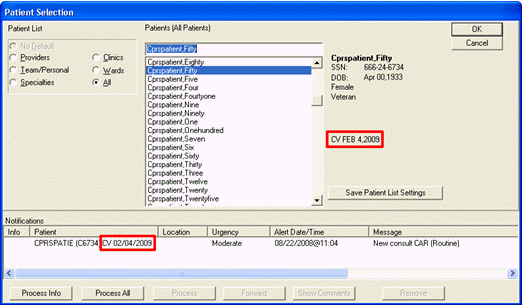
Upon electronic signature, providers will need to deal with the various exemptions for copayment for qualified veterans. To help providers better understand service connection and treatment factors, the following information is provided.
Service Connected
The assignment of service connected percentage and disability code is based on the degree of disability as determined by the rating board decision following the submission of a claim that a veteran's illness or injury was incurred in or aggravated by military service.
An adjunct condition, although not service connected, is medically determined to be associated with or is aggravating a disease or condition, which is service connected. A veteran is eligible to receive treatment for an adjunct condition; however, because the adjunct is not a condition that is specifically rated, VA can bill the insurance carrier as well as those veterans responsible for copayments for treatment provided for the adjunct condition.
A secondary condition is defined as a condition that has been caused or is the result of a service-connected condition. This condition is also nonservice-connected and treatment provided is also billable.
It is important that the clinician be aware of the patient's service-connected conditions. This information is available by clicking the patient's name in the blue square in the upper left corner in CPRS. It is also found on the encounter form. If a patient is being treated for a service-connected condition during a visit, the provider should check the service-connected box on the encounter form "yes".
Compensable service-connected veterans are not charged an outpatient copayment. However, nonservice-connected veterans and veterans rated less than 50% service-connected with income above the existing threshold may be charged a medication copayment if the medication is for a nonservice-connected condition. If the veteran has health insurance, a claim will be submitted to the insurance carrier for the treatment of nonservice-connected conditions.
Treatment Factors/Environmental Indicators
The provider must make a clinical decision to determine if an encounter is for a SC condition or one of a number of special categories. If the veteran is being treated during the encounter for a condition that the provider believes is for SC or a special category, the provider should check "Yes" next to the appropriate category on the encounter form. The veteran will not be billed for the encounter if "Yes" is checked.
Medication(s) for one of these conditions should be indicated during the outpatient medication ordering process. The veteran will not be charged a copayment for a medication that is for SC or a special category.
The Special Categories included are:
· Southwest Asia Conditions (SWAC) includes Gulf War veterans
· Shipboard Hazard and Defense (SHD)
· Military Sexual Trauma (MST)
· Head and Neck Cancer (HNC), after nasopharyngeal radium treatment in service.
Combat Veteran
Overview of Combat Veteran Status
To qualify for the Combat Veteran (CV) exemption, the veteran must have served in combat operations after the Gulf War or in combat against a hostile force after November 11, 1998. In addition, the condition for which the veteran is treated must be related to that combat, the veteran must have registered as a combat veteran, and be within two years of separation from active military service. Finally, the condition must not be already considered to be service related or that exemption should apply.
Note: The Combat Veteran exemption is valid for two years from the date of separation from military service, not the registration date. For example, if a veteran registers for Combat Veteran status 18 months after the date of his or her separation, the veteran would be eligible for Combat Veteran exemption for six months only. For further details, see VHA Directive 2002-049, Combat Veterans Are Eligible for Medical Services for 2-Years after Separation from Military Service Notwithstanding Lack of Evidence for Service Connection.
To help users better identify Combat Veteran eligible patients so that appropriate care and prioritization occur for them, CPRS has added several items where Combat Veteran status is more clearly shown. This is especially true in Consults. These markers are shown in various places in CPRS, such as the Patient Selection screen, the buttons available from any tab, the Consults dialog and details, the SF-513 form, etc.
· Patient Selection Screen: When the user selects a patient with Combat Veteran status, CPRS indicates that patient is a combat veteran by displaying the letters CV and a date below the normal demographic information on the Patient Selection screen and above the Save Patient List Settings button. The marker is shown in the screen capture below surrounded by a red box.

· New Service Consult/Request Notifications: The lower portion of the Patient Selection screen is the list of notifications for the user that is logged in. For a new consult or procedure request for a veteran with Combat Veteran status, the letters CV and the date display behind the abbreviated patient identifier in the Patient column. The Combat Veteran notification marker is shown in the above screen capture outlined in red.
· Combat Veteran Button and Consult Details: Available from any CPRS tab, the Combat Veteran button displays the letters CV and the expiration date of Combat Veteran Status. The Button displays when the selected patient has Combat Veteran status. The button shares space with the Flag button. The Combat Veteran button only displays for patients with the status, otherwise, the Flag button is whole.
o To get details, the user selects the button to display the Combat Veteran Details dialog. See Combat Veteran Details Dialog below.
o When the user selects the consults from the treeview, the consults details show in the pane to the right. In this view, the Combat Veteran status is shown underneath the primary eligibility.
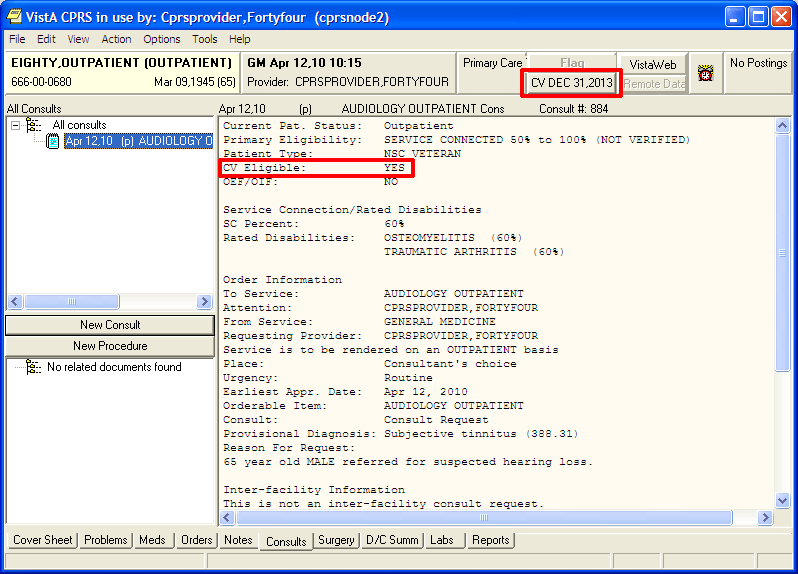
· Combat Veteran Details Dialog: When the user selects the Combat Veteran button, the Combat Veteran Details dialog displays with the following items:
o Service Branch
o Status
o Separation Date
o Expiration Date
o OEF/OIF (If the patient served in Operation Enduring Freedom (OEF) or Operation Iraqi Freedom (OIF)
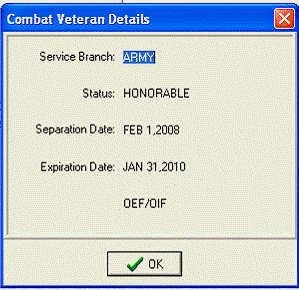
· Consult Order Dialog: The Combat Veteran status and expiration date display near the top of the Consult Order dialog.
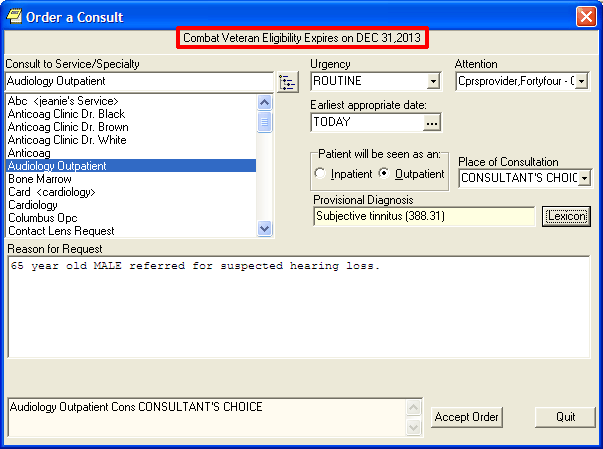
· SF-513 Form: Several changes were made to this form:
o At the top of the page on the SF-513, the Combat Veteran marker displays with the demographic information.
o The patient's name was moved to the top of this form.
o When printed, the patient's identifying information will be printed at the top of each page.
o When printed, a page number will be printed at the bottom of each page.
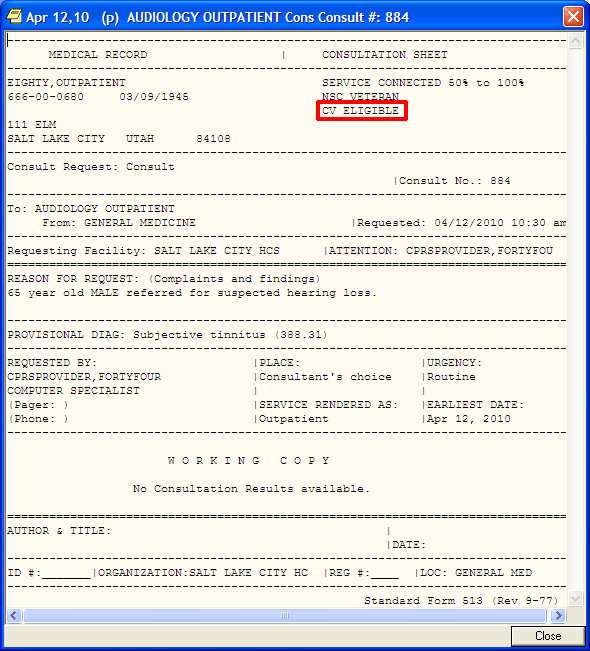
Agent Orange
Agent Orange (AO) is an herbicide that was used in Vietnam between 1962 and 1971 to remove unwanted plant life that provided cover for enemy forces. The VA has recognized the following conditions as associated with but not necessarily caused by exposure to Agent Orange:
Ionizing Radiation
Atomic veterans may have been exposed to ionizing radiation in a variety of ways at various locations. Veterans exposed at a nuclear device testing site (the Pacific Islands, e.g., Bikini, NM, NV, etc.) or in Hiroshima and/or Nagasaki, Japan, may be included. Atomic veterans with exposure to ionizing radiation are entitled to receive treatment for conditions for this exposure. VA has recognized the following conditions by statute or regulation as being associated with radiation exposure:
Conditions Associated with Ionizing Radiation:
· All cancers/malignancies
· Posterior subcapsular cataracts
· Non-malignant thyroid nodular disease
· Parathyroid adenoma
· Tumors of the brain and central nervous system
Note: Atomic veterans do not have to receive an Ionizing Radiation Registry Exam to have these special treatment eligibilities.
Southwest Asia Conditions
Gulf War veterans were exposed to a wide variety of environmental hazards and potential harmful substances during their service in Southwest Asia. These include depleted uranium, pesticides, the anti-nerve gas pill pyridostigmine bromide, infectious diseases, chemical and biological warfare agents, and vaccinations (including anthrax and botulinum toxoid), and oil well free smoke and petroleum products. VA recognizes that there are other health risk factors encountered by Gulf War veterans. Veterans with service during the Gulf War are entitled to receive treatment for conditions for this service.
If the treatment provided during the encounter is for an illness or symptom that may possibly be associated with environmental contamination this should be indicated on the encounter form or medication order
Conditions Associated with Southwest Asia Conditions:
· Persistent fatigue
· Skin rash
· Headache
· Arthralgias/myalgias
· Sleep disturbance
· Forgetfulness
· Joint pain
· Shortness of breath/chest pain
· Feverishness
· Amyotrophic Lateral Sclerosis
Shipboard Hazard and Defense
Veterans with conditions recognized by VA as associated with Project 112/ SHAD, shipboard and land-based biological and chemical testing conducted by the United States (U.S.) military between 1962 and 1973 are eligible for enrollment in priority group 6, unless eligible for enrollment in a higher priority. In addition, veterans receive care at no charge for care and medications provided for treatment of conditions related to exposure.
Military Sexual Trauma
VA is authorized by law to provide counseling services to women and men veterans who experienced incidents of sexual trauma while they served on active duty in the military. This Law defines a sexual trauma as sexual harassment, sexual assault, rape and other acts of violence. It further defines sexual harassment as repeated unsolicited, verbal or physical contact of a sexual nature, which is threatening in nature.
The provider must make a clinical decision to determine if a visit or medication is for MST. If the veteran is being treated for any condition during this episode of care that the provider believes is for MST; the visit should be checked as related on the encounter form and the medication should be designated as for MST. This will mean that the veteran does not have to pay a copayment for the visit or the medication.
Head and Neck Cancer
Veterans with cancer of the head and neck and a history of receipt of Nasopharyngeal (NP) radium therapy are eligible to receive treatment. There are very specific dates and locations where this activity occurred. Eligibility for this special class needs to be verified by HAS. (Not all veterans receiving head and neck cancer treatment fall into this treatment category.)
During the 1920s, nasopharyngeal (NP) radium therapy was developed to treat hearing loss caused by repeated ear infections. Radium-tipped rods were inserted into the nostrils and left in place for several minutes. Military physicians used NP radium to treat aerotitis media (barotrauma) in submariners, aviators, and divers. It is estimated that between 8,000 and 20,000 military personnel received NP radium treatments during World War II and until the 1960s. Veterans also included are those with documentation of NP radium treatment in active military, naval or air service; those who served as an aviator in the active military, naval or air service before the end of the Korean conflict; or underwent submarine training in active naval service before January 1, 1965. Veterans with exposure to NP radium treatments are eligible to receive treatment for conditions related head and neck cancer
If the veteran is being treated for any condition during this episode of care that is for Head and Neck Cancer; the visit should be checked as related on the encounter form and the medication should be designated for Head and Neck Cancer. This will mean that the veteran does not have to pay a copayment for the visit or the medication.
Camp Lejeune
From the 1950s to the 1980s, people living or working at the U.S. Marine Corps Base Camp Lejeune (CL), NC, were exposed to drinking water contaminated with industrial solvents, benzene, and other chemicals. Veterans and family members who served on active duty or resided at Camp Lejeune for 30 days or more between Aug. 1, 1953 and Dec. 31, 1987 may be eligible for VA health benefits for 15 conditions:
On August 6, 2012, President Obama signed into law the “Honoring America’s Veterans and Caring for Camp Lejeune Families Act of 2012” (P. L. 112-154). This law provides health care for Veterans who served on active duty at Camp Lejeune and reimbursement for health care to family members who resided at Camp Lejeune for not fewer than 30 days between August 1, 1953 and December 31, 1987. The law authorizes care for 15 medical conditions, even if there is insufficient medical evidence to conclude that such illnesses or conditions are attributable to the Veterans’ military service or family members’ residence at Camp Lejeune.
Note: The Camp Lejeune environmental indicator will not be available until the release of patch OR*3.0*407.
Related topics
CIDC: Entering Diagnosis Codes for Specific Orders